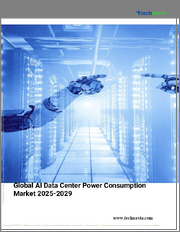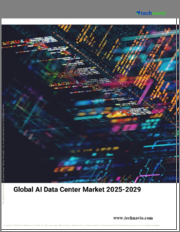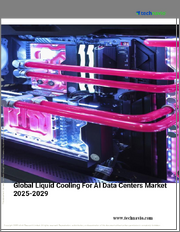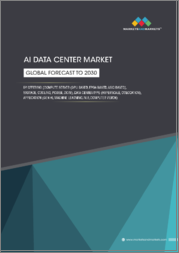
|
시장보고서
상품코드
1730677
세계의 AI 데이터센터 시장 평가 : 컴포넌트별, 데이터센터 유형별, 배포별, 최종사용자 업계별, 지역별, 기회, 예측(2018-2032년)Global AI Data Center Market Assessment, By Component, By Data Center Type, By Deployment, By End-user Industry, By Region, Opportunities and Forecast, 2018-2032F |
||||||
세계의 AI 데이터센터 시장 규모는 2025-2032년의 예측 기간 중 22.53%의 CAGR로 확대하며, 2024년 145억 달러에서 2032년에는 736억 6,000만 달러로 성장할 것으로 예측됩니다. 세계의 AI 데이터센터 시장은 헬스케어, 금융, 자동차, 통신 등 다양한 분야에서 AI 기반 기술이 발전하면서 디지털 시대의 동향을 정의하고 있으므로 빠르게 성장하고 있습니다.
AI 활용이 복잡해지고 대중화됨에 따라 방대한 양의 데이터가 생성되고 대규모 연산 능력이 필요해짐에 따라 워크로드를 처리하기 위한 AI 특화 데이터센터에 대한 수요가 증가하고 있습니다. 이러한 센터는 실시간 분석 및 머신러닝 모델을 처리하기 위해 GPU와 같은 하이엔드 하드웨어, 고급 냉각 인프라, 저지연 네트워크를 갖추고 있습니다. 조직은 프로세스 자동화, 고객 대응의 개인화, 데이터베이스 의사결정을 통한 경쟁력 강화를 위해 AI를 빠르게 도입하고 있습니다. 이러한 진화로 인해 전 세계에서 AI에 특화된 데이터센터 도입이 급증하고 있습니다. 또한 클라우드 기반 AI 서비스의 확산은 하이퍼스케일러와 코로케이션 프로바이더들에게 AI를 지원하는 인프라를 강화하도록 압박하고 있으며, 이 산업은 매우 역동적이고 혁신이 주도하는 산업이 되고 있습니다.
예를 들어 구글(Google LLC)은 2024년 3월, 자사 AI 제품 지원을 강화하기 위해 미국과 유럽 전역에 AI를 지원하는 데이터센터 인프라를 확장할 계획을 발표했습니다. 위의 사례는 세계 기술 대기업이 미래 지향적인 세계 AI 데이터센터 시장 창출을 위한 노력을 강화하고 있음을 보여줍니다.
세계의 AI 데이터센터 시장에 대해 조사했으며, 시장의 개요와 컴포넌트별, 데이터센터 유형별, 배포별, 최종사용자 업계별, 지역별 동향 및 시장에 참여하는 기업의 개요 등을 제공하고 있습니다.
목차
제1장 프로젝트 범위와 정의
제2장 조사 방법
제3장 미국 관세의 영향
제4장 개요
제5장 고객의 소리
제6장 세계의 AI 데이터센터 시장 전망, 2018-2032년
- 시장 규모 분석과 예측
- 시장 점유율 분석과 예측
- 컴포넌트별
- 하드웨어
- 소프트웨어
- 서비스
- 데이터센터 유형별
- 하이퍼스케일 데이터센터
- 코로케이션 데이터센터
- 기업 데이터센터
- 기타
- 배포별
- 온프레미스
- 클라우드
- 하이브리드
- 최종사용자 업계별
- 헬스케어
- 소매
- IT·통신
- BFSI
- 제조업
- 기타
- 지역별
- 북미
- 유럽
- 아시아태평양
- 남미
- 중동 및 아프리카
- 기업별 시장 점유율 분석(상위 5사 및 기타 - 금액별, 2024년)
- 컴포넌트별
- 2024년 시장 맵 분석
제7장 북미의 AI 데이터센터 시장 전망, 2018-2032년
- 시장 규모 분석과 예측
- 시장 점유율 분석과 예측
- 국가별
- 미국
- 캐나다
- 멕시코
제8장 유럽의 AI 데이터센터 시장 전망, 2018-2032년
- 독일
- 프랑스
- 이탈리아
- 영국
- 러시아
- 네덜란드
- 스페인
- 튀르키예
- 폴란드
제9장 아시아태평양의 AI 데이터센터 시장 전망, 2018-2032년
- 인도
- 중국
- 일본
- 호주
- 베트남
- 한국
- 인도네시아
- 필리핀
제10장 남미의 AI 데이터센터 시장 전망, 2018-2032년
- 브라질
- 아르헨티나
제11장 중동 및 아프리카의 AI 데이터센터 시장 전망, 2018-2032년
- 사우디아라비아
- 아랍에미리트
- 남아프리카공화국
제12장 Porter's Five Forces 분석
제13장 PESTLE 분석
제14장 시장 역학
- 시장 촉진요인
- 시장이 해결해야 할 과제
제15장 시장 동향과 발전
제16장 사례 연구
제17장 경쟁 구도
- 시장 리더 TOP 5의 경쟁 매트릭스
- 참여 기업 TOP 5의 SWOT 분석
- 시장의 주요 기업 TOP 10의 상황
- Amazon.com, Inc.
- Microsoft Corporation
- Alphabet Inc.
- Equinix, Inc.
- Intel Corporation
- NVIDIA Corporation
- Digital Realty Trust Inc.
- NTT Communications Corporation
- Cerebras Systems Inc.
- Ampere Computing LLC
제18장 전략적 제안
제19장 조사회사 소개·면책사항
KSA 25.06.05Global AI data center market is projected to witness a CAGR of 22.53% during the forecast period 2025-2032F, growing from USD 14.50 billion in 2024 to USD 73.66 billion in 2032. The global AI data center market is experiencing rapid growth due to the advancement of AI-driven technologies across the different sectors such as healthcare, finance, automotive, and telecommunications, defining the trend of the digital age.
As AI use becomes more complex and pervasive, it creates huge amounts of data and needs large computational capabilities, driving demand for AI-specialized data centers to handle workloads. Such centers have high-end hardware such as GPUs, advanced cooling infrastructure, and low-latency networks to handle real-time analytics and machine learning models. Organizations are quick to embrace AI to automate processes, make customer interactions more personalized, and derive competitive strengths through data-driven decision making. This evolution has spurred a global surge in AI-focused data center deployments. In addition, the cloud-based AI service movement is pressuring hyperscalers and colocation providers to ramp up infrastructure with AI-competent capability, making the industry extremely dynamic and innovation-led.
For instance, in March 2024, Google LLC rolled out plans to grow its data center infrastructure to support AI across the United States and Europe as part of improving support for its generative AI products. The above instances reflect the intensifying focus by world technology giants to create a global AI data center market fit for the future.
Growing Advancement in Technology is Proliferating the Global AI Data Center Market Growth
The growing deployment of artificial intelligence and machine learning in different sectors is driving the global AI data center market strongly. AI solutions-spanning natural language processing, computer vision, recommendation engines, and autonomous systems-require robust computing infrastructure and massive storage capabilities to operate effectively. These loads are computed and storage-intensive and need to be processed at high speed, for which typical data centers often lack the infrastructure. Therefore, firms are more often deploying AI-specified data centers with high-capacity GPUs, TPUs, and built-in AI chips.
Based on recent market trends, the AI market indicates a significant surge in the adoption of AI technologies and signaling an enormous increase in the volume of AI-created information, driving global market growth. To fulfill such changing needs, firms are investing in AI-optimized infrastructure. For instance, in May 2024, Microsoft Corporation announced the building of new data centers in Wisconsin, USA, designed specifically to handle AI workloads. The center will support the company's generation AI tools and services, increasing both capability and productivity.
Growing Focus on Sustainable and Energy-Efficient Infrastructure Drives AI Data Center Market
As AI data centers use enormous amounts of energy because of high loads and cooling, the global AI data center market is undergoing a drastic transformation towards energy efficiency and sustainability. In addition, an increased carbon emission scrutiny and energy price hikes, businesses have had to resort to innovative technology and renewable energy sources to operate their data centers. Green practices involve new cooling technology, AI-based energy optimization, and the utilization of renewable energy sources such as solar and wind.
Moreover, the pressure to minimize the environmental impact, companies are adopting green infrastructure and are achieving competitive advantage through enhanced brand value, reputation, reduced operating cost, and compliance. For instance, in December 2023, Google LLC announced plans to double its data center activity with a particular emphasis on sustainability, such as its new Nebraska data center, which is running on 100% wind energy. They also pledged to make all the AI computing units' carbon-neutral by 2030. Such steps show the extent to which sustainability factors are considered and influence the infrastructure planning. Also, the green data centers are becoming an integral part of AI rollout strategies worldwide, which is shaping the global AI data center market.
Colocation Services Hold Largest Market Share in Global Market
The colocation segment dominates global market growth for AI data centers as companies are demanding expandable, low-cost and efficient infrastructure solutions. With digital transformation accelerating across sectors, small and medium-sized firms (SMEs) are opting for colocation data centers as compared to building their own data centers. Such evolution allows companies to focus on their core business and unload third-party facilities for data safety storage, power supply, cooling, and network connectivity.
Additionally, colocation offers scalability and flexibility to companies according to requirements, which is essential in this digital data age. It also enables organizations to achieve data compliance, maintain operational continuity, and benefit from next-generation physical and cybersecurity, all without considerable capital investment. Growing adoption of hybrid clouds has also generated growing demand for colocation as businesses seek to merge on-premises infrastructure with cloud infrastructure in a seamless manner. Moreover, businesses are shifting towards colocation for faster deployment, data sovereignty needs, and operational efficiency. Strategic locations near city centers and fiber routes ensure low-latency access to end-users and cloud services. While AI is fueling data center requirements, the colocation market is also expected to witness strong growth on the strength of enterprise demand for scalable, high-security, and high-performance infrastructure without considerable upfront capital cost, further accelerating the expansion of the global AI data center market.
North America Holds a Significant Share in Global Market
North America has the largest percentage of global AI data center market due to its strong digital ecosystem, broad adoption of the cloud, and ongoing technology growth. This growth is also driven by leading global operators like Amazon Web Services (AWS), Microsoft, Google Cloud, and Meta, which continue to expand their data center footprints to meet growing demand from users and businesses worldwide. The robust IT infrastructure of the United States and Canada, driven by high-level connectivity, high-skilled resources, and favorable regulatory environments, presents an ideal platform for global AI data center market expansion. Besides, sectors such as BFSI, healthcare, e-commerce, and media are investing increasingly in digital transformation, which generates incessant demand for high-performance computing and secure data storage.
Moreover, North America has been spearheading the adoption of newer and more futuristic technologies such as artificial intelligence, big data, machine learning, and Internet of Things (IoT), making a valuable contribution by itself to speedier volumes of data as well as the demand for data processing. This has led enterprises to rely on infrastructure that is fault-tolerant and low-latency but scalable in features. This also boosted investments in newly built data centers. With strong government backing, continuous innovation, and smart partnerships between cloud vendors and AI players have driven the North America AI data center market growth.
Impact of U.S. Tariffs on Global AI Data Center Market
The U.S. tariffs imposed on imported hardware technology, especially from China, have placed cost pressures on the global AI data center market. Hardware components such as GPUs, servers, and semiconductors have become costly, impacting new build and expansion projects for AI-driven data centers. The tariffs are forcing companies to revisit supply chains, investigate alternative sources, and slow down goliath-scale rollouts to maintain rising costs at bay. Small and medium-sized enterprises are finding it hard to stay competitive because of tighter budgets. While the giants can weather the storm, others are relocating operations to nations with more stable trade policies. On the negative side, this relocation is creating homegrown manufacturing and strategic regional alliances, which could increase long-term supply chain resilience in the global AI data center market.
Key Players Landscape and Outlook
The global AI data center market is highly competitive and fragmented, consisting of several major technology companies actively investing in infrastructure, innovation, and partnerships to strengthen their market position. The companies are driving the next phase of growth in the AI data center space by offering advanced computing solutions, expanding global data center footprints, and integrating AI capabilities into their service portfolios. For instance, in 2024, Microsoft Corporation announced plans to invest USD 3.46 billion to double the artificial intelligence and cloud capacities in Germany. Such initiatives reflect how companies are aligning their infrastructure with the rising demand for AI services and enterprise cloud computing to train millions of people in digital skills.
Moreover, the AI data center market is expected to see increased activity around sustainability, as major players focus on building energy-efficient infrastructure to reduce carbon footprints. Green data centers, liquid cooling technologies, and renewable energy sourcing are gaining traction among leaders, driving global market growth. Additionally, the integration of AI for data center management, such as predictive maintenance and energy optimization, is likely to become standard.
Table of Contents
1. Project Scope and Definitions
2. Research Methodology
3. Impact of U.S. Tariffs
4. Executive Summary
5. Voice of Customers
- 5.1. Respondent Demographics
- 5.2. Brand Awareness
- 5.3. Factors Considered in Purchase Decisions
- 5.4. Challenges Faced Post Purchase
6. Global AI Data Center Market Outlook, 2018-2032F
- 6.1. Market Size Analysis & Forecast
- 6.1.1. By Value
- 6.2. Market Share Analysis & Forecast
- 6.2.1. By Component
- 6.2.1.1. Hardware
- 6.2.1.2. Software
- 6.2.1.3. Services
- 6.2.2. By Data Center Type
- 6.2.2.1. Hyperscale Data Center
- 6.2.2.2. Colocation Data Center
- 6.2.2.3. Enterprise Data Center
- 6.2.2.4. Others
- 6.2.3. By Deployment
- 6.2.3.1. On-Premises
- 6.2.3.2. Cloud
- 6.2.3.3. Hybrid
- 6.2.4. By End-user Industry
- 6.2.4.1. Healthcare
- 6.2.4.2. Retail
- 6.2.4.3. IT and Telecom
- 6.2.4.4. BFSI
- 6.2.4.5. Manufacturing
- 6.2.4.6. Others
- 6.2.5. By Region
- 6.2.5.1. North America
- 6.2.5.2. Europe
- 6.2.5.3. Asia-Pacific
- 6.2.5.4. South America
- 6.2.5.5. Middle East and Africa
- 6.2.6. By Company Market Share Analysis (Top 5 Companies and Others - By Value, 2024)
- 6.2.1. By Component
- 6.3. Market Map Analysis, 2024
- 6.3.1. By Component
- 6.3.2. By Data Center Type
- 6.3.3. By Deployment
- 6.3.4. By End-user Industry
- 6.3.5. By Region
7. North America AI Data Center Market Outlook, 2018-2032F
- 7.1. Market Size Analysis & Forecast
- 7.1.1. By Value
- 7.2. Market Share Analysis & Forecast
- 7.2.1. By Component
- 7.2.1.1. Hardware
- 7.2.1.2. Software
- 7.2.1.3. Services
- 7.2.2. By Data Center Type
- 7.2.2.1. Hyperscale Data Center
- 7.2.2.2. Colocation Data Center
- 7.2.2.3. Enterprise Data Center
- 7.2.2.4. Others
- 7.2.3. By Deployment
- 7.2.3.1. On-Premises
- 7.2.3.2. Cloud
- 7.2.3.3. Hybrid
- 7.2.4. By End-user Industry
- 7.2.4.1. Healthcare
- 7.2.4.2. Retail
- 7.2.4.3. IT and Telecom
- 7.2.4.4. BFSI
- 7.2.4.5. Manufacturing
- 7.2.4.6. Others
- 7.2.5. By Country
- 7.2.5.1. United States
- 7.2.5.2. Canada
- 7.2.5.3. Mexico
- 7.2.1. By Component
- 7.3. Country Market Assessment
- 7.3.1. United States AI Data Center Market Outlook, 2018-2032F
- 7.3.1.1. Market Size Analysis & Forecast
- 7.3.1.1.1. By Value
- 7.3.1.2. Market Share Analysis & Forecast
- 7.3.1.2.1. By Component
- 7.3.1.2.1.1. Hardware
- 7.3.1.2.1.2. Software
- 7.3.1.2.1.3. Services
- 7.3.1.2.2. By Data Center Type
- 7.3.1.2.2.1. Hyperscale Data Center
- 7.3.1.2.2.2. Colocation Data Center
- 7.3.1.2.2.3. Enterprise Data Center
- 7.3.1.2.2.4. Others
- 7.3.1.2.3. By Deployment
- 7.3.1.2.3.1. On-Premises
- 7.3.1.2.3.2. Cloud
- 7.3.1.2.3.3. Hybrid
- 7.3.1.2.4. By End-user Industry
- 7.3.1.2.4.1. Healthcare
- 7.3.1.2.4.2. Retail
- 7.3.1.2.4.3. IT and Telecom
- 7.3.1.2.4.4. BFSI
- 7.3.1.2.4.5. Manufacturing
- 7.3.1.2.4.6. Others
- 7.3.1.2.1. By Component
- 7.3.1.1. Market Size Analysis & Forecast
- 7.3.1. United States AI Data Center Market Outlook, 2018-2032F
All segments will be provided for all regions and countries covered
8. Europe AI Data Center Market Outlook, 2018-2032F
- 8.1. Germany
- 8.2. France
- 8.3. Italy
- 8.4. United Kingdom
- 8.5. Russia
- 8.6. Netherlands
- 8.7. Spain
- 8.8. Turkey
- 8.9. Poland
9. Asia-Pacific AI Data Center Market Outlook, 2018-2032F
- 9.1. India
- 9.2. China
- 9.3. Japan
- 9.4. Australia
- 9.5. Vietnam
- 9.6. South Korea
- 9.7. Indonesia
- 9.8. Philippines
10. South America AI Data Center Market Outlook, 2018-2032F
- 10.1. Brazil
- 10.2. Argentina
11. Middle East and Africa AI Data Center Market Outlook, 2018-2032F
- 11.1. Saudi Arabia
- 11.2. UAE
- 11.3. South Africa
12. Porter's Five Forces Analysis
13. PESTLE Analysis
14. Market Dynamics
- 14.1. Market Drivers
- 14.2. Market Challenges
15. Market Trends and Developments
16. Case Studies
17. Competitive Landscape
- 17.1. Competition Matrix of Top 5 Market Leaders
- 17.2. SWOT Analysis for Top 5 Players
- 17.3. Key Players Landscape for Top 10 Market Players
- 17.3.1. Amazon.com, Inc.
- 17.3.1.1. Company Details
- 17.3.1.2. Key Management Personnel
- 17.3.1.3. Key Products/Services Offered
- 17.3.1.4. Key Financials (As Reported)
- 17.3.1.5. Key Market Focus and Geographical Presence
- 17.3.1.6. Recent Developments/Collaborations/Partnerships/Mergers and Acquisition
- 17.3.2. Microsoft Corporation
- 17.3.3. Alphabet Inc.
- 17.3.4. Equinix, Inc.
- 17.3.5. Intel Corporation
- 17.3.6. NVIDIA Corporation
- 17.3.7. Digital Realty Trust Inc.
- 17.3.8. NTT Communications Corporation
- 17.3.9. Cerebras Systems Inc.
- 17.3.10. Ampere Computing LLC
- 17.3.1. Amazon.com, Inc.
Companies mentioned above DO NOT hold any order as per market share and can be changed as per information available during research work.



















